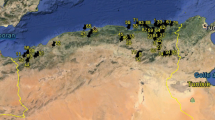Abstract
A survey of seed protein profiles inP. pilosa revealed three bands in addition to the typical complement in northern Illinois and Indiana populations. One of the novel proteins has the same (fast) migration velocity as a protein in the standard complement ofP. glaberrima. Both of these proteins hybridize with one of the standardP. pilosa proteins to produce two additional bands. The fast protein varies in frequency between populations and is most prevalent in areas where there is the greatest potential for hybridization withP. glaberrima. These data suggest that the fast band ofP. pilosa may have been introduced fromP. glaberrima despite strong incompatibility barriers, and increased in frequency through selective accumulation.
Similar content being viewed by others
Literature Cited
Altschul, A. M., L. Y. Yatsu, R. L. Ory, &E. M. Engleman 1966. Seed proteins. Annual Rev. Pl. Physiol.17: 113–136.
Antonovics, J. 1968. Evolution in closely adjacent populations. VI. Manifold effects of gene flow. Heredity23: 507–524.
Boulter, D., D. A. Thurman, &E. Derbyshire 1967. A disc electrophoresis study of globulin proteins of legume seeds with reference to their systematics. New Phytol.66: 27–36.
Boyd, W. J. R. &J. W. Lee 1967. The control of wheat glutin synthesis at the genome and chromosome levels. Experientia23: 332–333.
Cherry, J. P., F. R. H. Katterman, &J. E. Endrizzi 1970. Comparative studies of seed proteins of species ofGossypium by gel electrophoresis. Evolution24: 431–447.
Davis, B. J. 1964. Disc electrophoresis. II. Methods and application. Ann. New York Acad. Sci.121: 404–427.
Dunnhill, P. M. &L. Fowden 1965. The amino acids of seeds of the Cucurbitaceae. Phytochemistry4: 933–944.
Epling, C., H. Lewis, &F. M. Ball 1960. The breeding group and seed storage: a study in population dynamics. Evolution14: 238–255.
Fox, D. J., D. A. Thurman, &D. Boulter 1964. Studies on the proteins of the seeds of the Leguminosae. I. Albumins. Phytochemistry3: 417–419.
Gajewski, W. 1957. A cytogenetic study on the genusGeum L. Monogr. Bot.4: 1–415.
Garcia-Olmedo, F. &P. Carbonero 1970. Homeologous protein synthesis controlled by homeologous chromosomes in wheat. Phytochemistry9: 1495–1497.
Harlan, J. R. & J. M. J. de Wet 1963. The compilospecies concept. Evolution17: 497–501.
Harper, J. L., P. H. Lovell, &K. G. Moore 1970. The shapes and size of seeds. Annual Rev. Ecol. Syst.1: 327–356.
Heiser, C. B. 1951. Hybridization in the annual sunflowers:Helianthus annus XH. debilis var.cucumerifolius. Evolution5: 42–51.
Hunziker, J. H. 1967. Chromosome and protein differentiation in theAgropyron scabriglume complex. Taxon16: 259–266.
Jackson, P., J. M. Milton, &D. Boulter 1967. Fingerprint patterns of the globulin fraction obtained from seeds of various species of the Fabaceae. New Phytol.66: 47–56.
Johnson, B. L. 1969. The protein electrophoresis approach to species relationships in wheat. pp. 19–41.In: R. Bogart [ed.], Lectures in Genetics. Vol. 1. Oregon State Univ. Press, Corvallis.
Larson, A. L. &B. E. Caldwell 1968. Inheritance of certain proteins in soybean seed. Crop Sci.8: 474–476.
Lee, J. W. &J. A. Ronalds 1967. Effect of environments on wheat gliadin. Nature (London)213: 844–846.
Levin, D. A. 1966. ThePhlox pilosa complex: Crossing and chromosome relationships. Brittonia18: 142–162.
— 1967a. Natural selection for reproductive isolation inPhlox. Evolution21: 679–687.
— &H. W. Kerster 1968. Local gene dispersal inPhlox. Evolution22: 130–139.
— 1971. Secondary intergradation and genome incompatibility inPhlox pilosa. Brittonia23: 246–265.
— 1970a. Reticulate evolution inPhlox as seen through protein electrophoresis. Amer. J. Bot.57: 977–987.
— &B. A. Schaal 1970b. Corolla color as an inhibitor of interspecific hybridization inPhlox. Amer. Naturalist104: 273–283.
Markert, C. L. 1963. Lactate dehydrogenase: dissociation and recombination of subunits. Science140: 1329–1330.
McDaniel, R. G. &R. T. Ramage 1970. Genetics of a primary trisomic series in barley: identification by protein electrophoresis. Canad. J. Genet. Cytol.12: 490–495.
Moore, D. M. 1959. Population studies onViola lactea Sm. and its wild hybrids. Evolution13: 318–332.
Ornstein, L. 1964. Disc electrophoresis. I. Background and theory. Ann. New York Acad. Sci.121: 321–349.
Scandalios, J. G. 1965. Subunit dissociation and recombination of catalase isozymes. Proc. Natl. Acad. U.S.A.53: 1035–1040.
— 1969. Genetic control of multiple molecular forms of enzymes in plants: a review. Biochem. Genet.3: 37–79.
Selander, R. K. 1970. Behavior and genetic variation in natural populations. Amer. Zool.10: 53–66.
Shepherd, K. W. 1968. Chromosomal control of endosperm proteins in wheat and rye, pp. 86–96.In: K. W. Finlay & K. W. Shepherd [eds.], Proc. Third International Wheat Genetics Symposium. New York: Plenum. 479 pp.
Stephens, S. G. 1949. The cytogenetics of speciation inGossypium. I. Selective elimination of donor parent genotype in interspecific backcrosses. Genetics34: 627–637.
Turner, B. L. 1970. Molecular approaches to population problems at the intraspecific level, p. 187–205.In: J. B. Harborne [ed.], Phytochemical Phylogeny. New York: Academic Press 335 pp.
Vaughan, J. G., A. T. Waite, D. Boulter, &S. Walters 1966. Comparative studies of the seed proteins ofBrassica campestris, Brassica oleracea, andBrassica nigra. J. Expt. Bot.17: 332–343.
— &K. E. Denford 1968. An acrylamide gel electrophoretic study of the seed proteins ofBrassica andSinapis species, with special reference to their taxonomic value. J. Exp. Bot.19: 724–732.
Wall, J. R. 1968. Leucine aminopeptidase polymorphism inPhaseolus and differential elimination of the donor parent genotype in interspecific backcrosses. Biochem. Genet.2: 109–118.
— 1971. Genetic control of leucine aminopeptidase and esterase isozymes in the interspecific crossCucurbita ecuadorensis XC. maxima. Biochem. Genet.5: 223–229.
Author information
Authors and Affiliations
Rights and permissions
About this article
Cite this article
Levin, D.A., Schaal, B.A. Seed protein polymorphism in Phlox pilosa (Polemoniaceae). Brittonia 24, 46–56 (1972). https://doi.org/10.2307/2805546
Issue Date:
DOI: https://doi.org/10.2307/2805546




